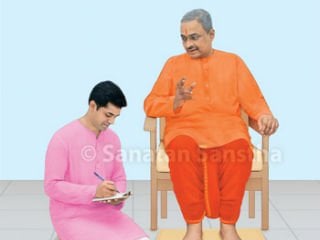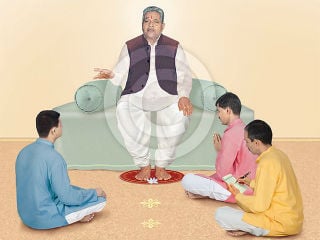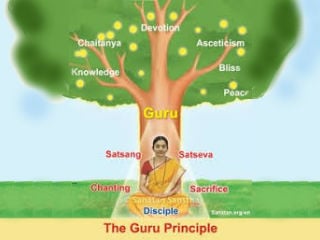तद्विद्धि प्रणिपातेन परिप्रश्नेन सेवया ।
उपदेक्ष्यन्ति ते ज्ञानं ज्ञानिनस्तत्त्वदर्शिनः ।। – श्रीमद्भगवद्गीता, अध्याय ४, श्लोक ३४
Meaning : Acquire spiritual knowledge (dnyan) by going to the Guru, offer obeisance (namaskar), ask questions and do service. The Guru possessing immense spiritual knowledge and experience will endow you with that knowledge. ‘This verse (shloka) itself describes the following three types of disciples.
1. The superior disciple
When the one who has a desire to acquire knowledge of the soul principle, that is, a superior seeker offers obeisance to one who has experienced the Absolute Principle (the Sadguru), the latter bestows the seeker with spiritual knowledge (dnyan). The superior disciple is a seeker who inspite of being trapped in unhappiness in the state of the embodied soul is convinced that “I am not the embodied soul but am really The Supreme God (Shiv)” through the study of the scriptures. He is the one who has overcome the anadi (one without a beginning) illusion but has not gone beyond the state of the embodied soul (jivadasha) and is thus not experiencing the state of The Shiv (Brahman) principle. He struggles just like a fish out of water for a Guru and wanders in search of Him. In such a situation God Himself appears before him assuming the form of his Shri Guru. After the seeker has offered obeisance, that is after his complete surrender to the Guru, when the Guru gives him a mere glance he feels that he has accomplished the very essence of his existence.
The quote by Saint Tukaram which means, “He moulds one like Himself at once, it requires hardly any time” is in the context of such a disciple.
In His Dakshinamurti verse (stotra) Shri Shankaracharya ‘गुरोस्तु मौनं व्याख्यानं शिष्यास्तु छिन्नसंशयाः ।’This means that the Guru taught through silence (moun) and got rid of all the disciple’s doubts. Brahman is the nature of the soul and cannot be described in words. The adjective wordless is affixed to It, that is It is referred to as “The Wordless Brahman”. For the superior seeker silence (moun) itself is the real deliverance, the teaching. He is rid of all doubts at that very moment and acquires the spiritual emotion (bhav) of non-duality. He begins to experience the entire world from the sky to even his own body to be composed of Brahman. A superior seeker is one with an intense desire for Liberation (mumukshu).Since Arjun (from the Mahabharat) was endowed with divine qualities one may refer to Him as a superior seeker. ‘Saint Dnyaneshvar says, “Only those who are capable of being in the same class as Arjun really deserve to hear the Gita”. The word Arjun can be defined as ‘शुद्धान्तःकरणयुक्तः इति अर्जुनः ।’ meaning that the one with a pure antahkaran is Arjun. After the deliverance of the Gita, Arjun says,
नष्टोमोहः स्मृतिर्लब्धा त्वत्प्रसादान्मयाऽच्युत ।
स्थितोऽस्मि गतसन्देहः करिष्ये वचनं तव ।। – श्रीमद्भगवद्गीता, अध्याय १८, श्लोक ७३
Meaning : I have lost the attachment that “I am the body” and have regained the realisation that “I am Brahman”. All this is the result of remaining in Your company. Now that I am free of doubts, I am sure that I shall be able to obey Your directives.’ This means that he was worthy of receiving this most secret teaching. Such a seeker has a sattvik (sattva predominant) temperament. A superior seeker does not fall prey to any supernatural powers (riddhi-siddhis) attained during the course of his spiritual practice. Even if the hitherto unrevealed secrets of this universe were to lie exposed before him, they would be unable to divert him from his ultimate target even for a fraction of a second and he would attain the state of Absoluteness. The superior seeker is the one worthy of Sage Vyas’s quote, ‘शिष्यादिच्छेत् पराजयम् ।’ meaning that the Guru should expect defeat from His disciple. This implies that the Guru expects His disciple to merge into God.
2. The medium disciple
The Guru imparts spiritual knowledge to him by answering his questions. Since he is yet to master the Yogas, that is the art of being one with God (yogarudh) he is qualified only to do spiritual practice from the path of Action (karmasadhana). Such a seeker predominantly has combination of sattva and raja temperaments.
3. The inferior disciple
A Guru gets a lot of service done from him and then imparts him with spiritual knowledge. He needs to do spiritual practice for several births. He is predominantly of the rajasik (raja predominant) temperament. The medium and inferior disciples can gradually become superior but this constitutes a rare exception. One comes across many who have fallen prey to supernatural powers (riddhi-siddhis), desire to be respected by others (lokeshana), etc.’
– H.H. Kane Maharaj, Narayangaon

 The one and only Guru-disciple tradition of the Sanatan Sanstha which has proven special in...
The one and only Guru-disciple tradition of the Sanatan Sanstha which has proven special in... Who is proclaimed a Saint as per Science of Spirituality ?
Who is proclaimed a Saint as per Science of Spirituality ? Faith & Guru
Faith & Guru Who is a real Guru ?
Who is a real Guru ? The Guru Principle
The Guru Principle Offering gratitude unto the Holy feet of the Guru is true Gurudakshina !
Offering gratitude unto the Holy feet of the Guru is true Gurudakshina !